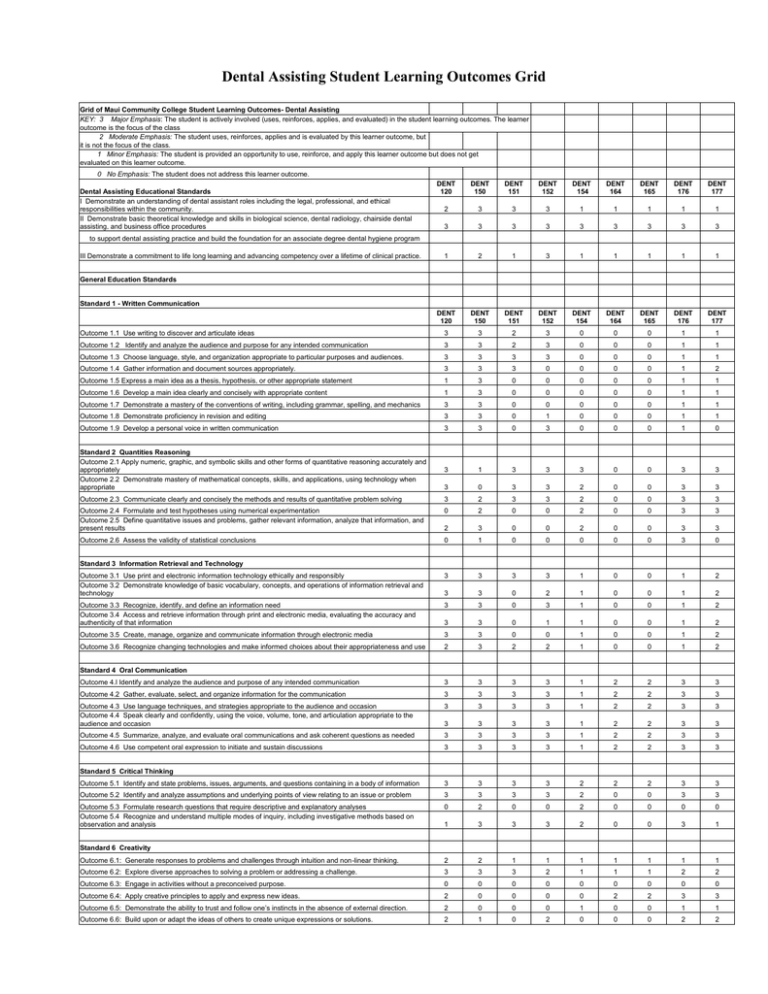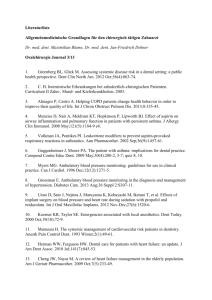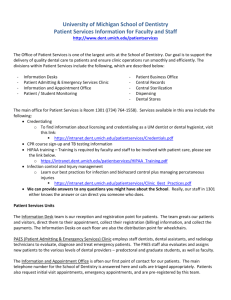Dental Assisting (DENT) 151, 152, 177, Grid
advertisement

Dental Assisting Student Learning Outcomes Grid Grid of Maui Community College Student Learning Outcomes- Dental Assisting KEY: 3 Major Emphasis: The student is actively involved (uses, reinforces, applies, and evaluated) in the student learning outcomes. The learner outcome is the focus of the class 2 Moderate Emphasis: The student uses, reinforces, applies and is evaluated by this learner outcome, but it is not the focus of the class. 1 Minor Emphasis: The student is provided an opportunity to use, reinforce, and apply this learner outcome but does not get evaluated on this learner outcome. 0 No Emphasis: The student does not address this learner outcome. DENT 120 DENT 150 DENT 151 DENT 152 DENT 154 DENT 164 DENT 165 DENT 176 DENT 177 2 3 3 3 1 1 1 1 1 3 3 3 3 3 3 3 3 3 1 2 1 3 1 1 1 1 1 DENT 120 DENT 150 DENT 151 DENT 152 DENT 154 DENT 164 DENT 165 DENT 176 DENT 177 Outcome 1.1 Use writing to discover and articulate ideas 3 3 2 3 0 0 0 1 1 Outcome 1.2 Identify and analyze the audience and purpose for any intended communication 3 3 2 3 0 0 0 1 1 Outcome 1.3 Choose language, style, and organization appropriate to particular purposes and audiences. 3 3 3 3 0 0 0 1 1 Outcome 1.4 Gather information and document sources appropriately. 3 3 3 0 0 0 0 1 2 Outcome 1.5 Express a main idea as a thesis, hypothesis, or other appropriate statement 1 3 0 0 0 0 0 1 1 Outcome 1.6 Develop a main idea clearly and concisely with appropriate content 1 3 0 0 0 0 0 1 1 Outcome 1.7 Demonstrate a mastery of the conventions of writing, including grammar, spelling, and mechanics 3 3 0 0 0 0 0 1 1 Outcome 1.8 Demonstrate proficiency in revision and editing 3 3 0 1 0 0 0 1 1 Outcome 1.9 Develop a personal voice in written communication 3 3 0 3 0 0 0 1 0 Standard 2 Quantities Reasoning Outcome 2.1 Apply numeric, graphic, and symbolic skills and other forms of quantitative reasoning accurately and appropriately Outcome 2.2 Demonstrate mastery of mathematical concepts, skills, and applications, using technology when appropriate 3 1 3 3 3 0 0 3 3 3 0 3 3 2 0 0 3 3 Outcome 2.3 Communicate clearly and concisely the methods and results of quantitative problem solving 3 2 3 3 2 0 0 3 3 Outcome 2.4 Formulate and test hypotheses using numerical experimentation Outcome 2.5 Define quantitative issues and problems, gather relevant information, analyze that information, and present results 0 2 0 0 2 0 0 3 3 2 3 0 0 2 0 0 3 3 Outcome 2.6 Assess the validity of statistical conclusions 0 1 0 0 0 0 0 3 0 Outcome 3.1 Use print and electronic information technology ethically and responsibly Outcome 3.2 Demonstrate knowledge of basic vocabulary, concepts, and operations of information retrieval and technology 3 3 3 3 1 0 0 1 2 3 3 0 2 1 0 0 1 2 Outcome 3.3 Recognize, identify, and define an information need Outcome 3.4 Access and retrieve information through print and electronic media, evaluating the accuracy and authenticity of that information 3 3 0 3 1 0 0 1 2 3 3 0 1 1 0 0 1 2 Outcome 3.5 Create, manage, organize and communicate information through electronic media 3 3 0 0 1 0 0 1 2 Outcome 3.6 Recognize changing technologies and make informed choices about their appropriateness and use 2 3 2 2 1 0 0 1 2 Outcome 4.l Identify and analyze the audience and purpose of any intended communication 3 3 3 3 1 2 2 3 3 Outcome 4.2 Gather, evaluate, select, and organize information for the communication 3 3 3 3 1 2 2 3 3 Outcome 4.3 Use language techniques, and strategies appropriate to the audience and occasion Outcome 4.4 Speak clearly and confidently, using the voice, volume, tone, and articulation appropriate to the audience and occasion 3 3 3 3 1 2 2 3 3 3 3 3 3 1 2 2 3 3 Outcome 4.5 Summarize, analyze, and evaluate oral communications and ask coherent questions as needed 3 3 3 3 1 2 2 3 3 Outcome 4.6 Use competent oral expression to initiate and sustain discussions 3 3 3 3 1 2 2 3 3 Outcome 5.1 Identify and state problems, issues, arguments, and questions containing in a body of information 3 3 3 3 2 2 2 3 3 Outcome 5.2 Identify and analyze assumptions and underlying points of view relating to an issue or problem 3 3 3 3 2 0 0 3 3 Outcome 5.3 Formulate research questions that require descriptive and explanatory analyses Outcome 5.4 Recognize and understand multiple modes of inquiry, including investigative methods based on observation and analysis 0 2 0 0 2 0 0 0 0 1 3 3 3 2 0 0 3 1 Outcome 6.1: Generate responses to problems and challenges through intuition and non-linear thinking. 2 2 1 1 1 1 1 1 1 Outcome 6.2: Explore diverse approaches to solving a problem or addressing a challenge. 3 3 3 2 1 1 1 2 2 Outcome 6.3: Engage in activities without a preconceived purpose. 0 0 0 0 0 0 0 0 0 Outcome 6.4: Apply creative principles to apply and express new ideas. 2 0 0 0 0 2 2 3 3 Outcome 6.5: Demonstrate the ability to trust and follow one’s instincts in the absence of external direction. 2 0 0 0 1 0 0 1 1 Outcome 6.6: Build upon or adapt the ideas of others to create unique expressions or solutions. 2 1 0 2 0 0 0 2 2 Dental Assisting Educational Standards I Demonstrate an understanding of dental assistant roles including the legal, professional, and ethical responsibilities within the community. II Demonstrate basic theoretical knowledge and skills in biological science, dental radiology, chairside dental assisting, and business office procedures to support dental assisting practice and build the foundation for an associate degree dental hygiene program III Demonstrate a commitment to life long learning and advancing competency over a lifetime of clinical practice. General Education Standards Standard 1 - Written Communication Standard 3 Information Retrieval and Technology Standard 4 Oral Communication Standard 5 Critical Thinking Standard 6 Creativity



